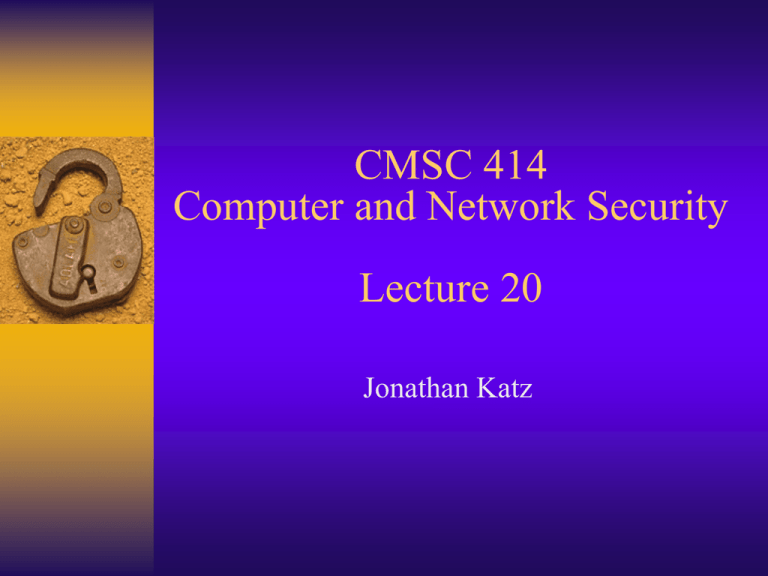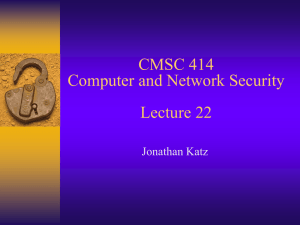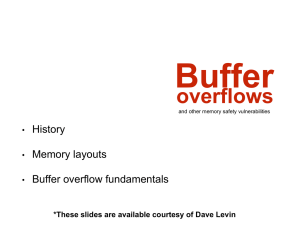Slides for lecture 20
advertisement

CMSC 414 Computer and Network Security Lecture 20 Jonathan Katz Role-based access control RBAC Controls based on a user’s (current) role, not their identity Users assigned to different roles – Can encode this in a matrix with users as rows, and roles as columns – A user can have multiple roles assigned – User can select current role based on their current function Access controls based on roles – Can use a “access matrix”, where subjects are roles RBAC: basic idea Users Roles Resources research Server 1 marketing Server 2 admin Server 3 RBAC Advantages – Users change more frequently than roles, RBAC has lower administrative overhead – More compact than a full-blown access control matrix – Least privilege – users can take on roles as needed Groups vs. roles A group is a (largely static) set of principals A role defines a set of access permissions – Different users take on different roles at different times Military analogy: – The group of users who are sargeants – The role of “person on watch duty” Buffer overflows Buffer overflows Previous focus in this class has been on secure policies and mechanisms For real-world security, security of the policy / mechanism is not enough -- the implementation must also be secure – We have seen this already when we talked about sidechannel attacks – Here, the attacks are active rather than passive – Also, here the attacks exploit the way programs are run by the machine/OS Importance of the problem Most common cause of ‘technical’ attacks – Over 50% of CERT advisories related to buffer overflow vulnerabilities Morris worm (1988) – 6,000 machines infected CodeRed (2001) – 300,000 machines infected in 14 hours Etc. Buffer overflows Fixed-sized buffer that is to be filled with unknown data, usually provided directly by user If more data “stuffed” into the buffer than it can hold, that data spills over into adjacent memory If this data is executable code, the victim’s machine may be tricked into running it Can overflow on the stack or the heap… A glimpse inside a computer Registers EBP ESP EIP function frame stack heap/ memory code Registers Special memory adjacent to the CPU – Provides extremely fast access – But only a limited number of registers Some are general purpose, some are specific Three specific ones we will care about: – EIP (instruction pointer, aka program counter) – ESP (stack pointer) – EBP (frame pointer) Code Instructions to be run, written in machine language – Machine specific – We assume x86 architecture here The EIP register contains the address of the next instruction to be executed – Typically, as each instruction is executed the EIP is incremented by the appropriate amount – EIP can also change based on control flow (e.g., a JMP or a function call) Stack Each function that is executed is allocated its own frame on the stack – This frame stores local variables, function parameters – Also stores EIP/EBP When one function calls another, a new frame is initialized and placed (pushed) on the stack When a function is finished executing, its frame is taken (popped) off the stack Traditionally, the stack grows toward lower memory addresses Frames and function calls local vars frame for caller function saved ebp saved eip function arguments local vars memory grows this way frame for callee function function arguments Stacks/frames The ESP always contains the address of the top- most entry on the stack When a value is pushed to the stack – The value is placed directly above the top-most entry, and the ESP is decremented When a value is popped from the stack – The value is read, and the ESP is incremented – The value is not deleted from memory (but it will be overwritten as later values are pushed to the stack) • This can be a potential security vulnerability as well Stacks/frames The EBP contains the address of the bottom of the current frame – I.e., the address of the saved EBP The EBP only changes when a frame is pushed on / popped off the stack, not when individual values are pushed/popped Function calls I EIP pointing to instruction “CALL <address>” – The EIP of the instruction to execute after the call returns (the saved EIP) is pushed on the stack – EIP changed to the address of the called code Function preamble – The current EBP (the saved EBP) is pushed to the stack – The EBP is set equal to the current ESP – The ESP is decremented to leave enough space on the stack for the current function frame Function calls II Function leave/return – The ESP is set equal to the EBP • The has the effect of popping the current frame – Pop the stack and set the EBP to the popped value • This was the saved EBP – Pop the stack and set the EIP to the popped value • This was the saved EIP Watching code execution using OllyDbg Buffer overflows The problem is that some functions that read user input are “unsafe” – E.g. (in C), gets, strcpy read input until the first null character – even if the destination buffer is too small! – Results from one buffer “overflow” into the other “Simple” buffer overflow Overflow one variable into another color price EBP EIP args Frame of the calling function locals vars gets(color) – What if I type “blue 1” ? – (Actually, need to be more clever than this) More devious examples… strcpy(buf, str) bufoverflowEBP EIP Frame of the calling function Pointer to This will be Execute previous interpreted code at frame as athis return address! address after func() finishes What if str has more than buf can hold? – Problem: strcpy does not check that str is shorter than buf Overwrite EIP, change expected control flow of program (cf. in-class examples) Examples using gdb











